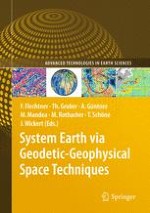2010 | OriginalPaper | Chapter
Improved GRACE Level-1 and Level-2 Products and Their Validation by Ocean Bottom Pressure
Author : Frank Flechtner
Published in: System Earth via Geodetic-Geophysical Space Techniques
Publisher: Springer Berlin Heidelberg
Activate our intelligent search to find suitable subject content or patents.
Select sections of text to find matching patents with Artificial Intelligence. powered by
Select sections of text to find additional relevant content using AI-assisted search. powered by
